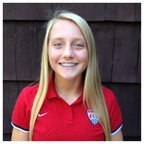When should your soccer kid ‘play up’? A conversation with youth national teamer Frankie Tagliaferri
 Do you remember when we all “played up”? Back then, we called it playing in the neighborhood. We all met in someone’s backyard or in a field or park with a large, flat open space and we brought a ball, tossed out some sweatshirts for bases or to mark end zones.
Do you remember when we all “played up”? Back then, we called it playing in the neighborhood. We all met in someone’s backyard or in a field or park with a large, flat open space and we brought a ball, tossed out some sweatshirts for bases or to mark end zones.
We were boys and girls of varying ages; all we had in common was our neighborhood and the love of play. Everyone except the oldest “played up.” We chose up teams and made our own rules – which we may or may not have modified for younger, less able players. Sure, we got thrown out a bit more often on our way to first base, and that was okay, because then you got to play in the field. Usually, they let you try to catch the pop-up yourself, even when they knew you would miss it, because that was the way we played.
+ READ: Playing up: Is developing their skills worth giving up our win?
Such a pure time of youthful formation, unencumbered by adults and their organizing age groups, leagues, division structures, qualification systems, tryouts, call-ups and elite selection matrices. We may not have invented “playing up,” but in many ways it invented us.
So why do we consider playing up an age or two on our soccer teams such a new idea? It’s been around approximately forever. Today it is scrutinized, feared and distrusted, a meddling with the normal course of things. Since my neighborhood play days, things have changed.
We’ve gotten away from tossing all ability levels into the pot to see how they all mix together. We would prefer to rank and categorize, then separate into learning levels, with each participant surrounded by peers of similar abilities. Oh, but let us not number those levels, for fear of labeling or damaging self-esteem.
I still remember being grouped in colored sections in middle school. I can’t remember if I was yellow or orange or green, but everyone knew who the smart kids were; the labels weren’t fooling anyone. But this practice was socially and politically proper, recommended for preserving our developing self-esteems. They were doing what they thought best for us kids.
We are still trying to do what we think best for our kids. We, the parents, that is. But, we don’t trust the system. And why should we? Those clubs and organizations are not set up to look out for my kid.
+ READ: Five life lessons the World Cup can teach your kids
Sure, at the beginning levels, they are meant to serve all the kids — well and good — but I don’t have just any kid. Mine is special. So I encourage her to try out for the select team; she more than makes it, she kills it. Told you she was special.
 Now, this is really fun. Every weekend, I get to see her dominate the game. It’s an off day when she hasn’t scored two or three goals. We celebrate the win, go out for ice cream, and reel in all the “great game!” praises. It’s great being the parent of the star of the team, isn’t it?
Now, this is really fun. Every weekend, I get to see her dominate the game. It’s an off day when she hasn’t scored two or three goals. We celebrate the win, go out for ice cream, and reel in all the “great game!” praises. It’s great being the parent of the star of the team, isn’t it?
Until you get that call from the “elite” club team in your area.
“We’ve seen your daughter play, and we think she’d be a great addition to our roster. With us she’d have access to the highest levels of coaching and training, be introduced to the most competitive levels of play and get exposure in front of college and national team level coaches. What do ya say?”
(Which, your mind translates to: As a good parent, how in the world can I deny her this opportunity? Cost be damned!)
In your pausing to perhaps consider the travel expenses, they add, “We have an academy system which will allow us to keep her challenged, even beyond the level of her own age group.” (Which your mind translates to: Yes! We will never have to go looking for a team again. This is all she will ever need!)
Which is what we good parents always seek to supply… all they will ever need. But we can’t, we won’t be that forever. We shouldn’t be. But the “what ifs” soon creep in. What if it this is hard for them? This is one of those great transitional moments when we can shift just a smidge from ‘looking out for them’ to ‘teaching them to look out for themselves.’ Perhaps that is the question to ask of her current playing environment: is it challenging her to be better?
+ READ: LeBolt: We have a broken system when it comes to dealing with head injuries
Sure, it’s rewarding. Sure, it’s fun. Sure, it’s affirming. We could stop there. But, to borrow from the late philosopher and theologian, Dallas Willard, “If you’re the smartest person in the room, you’re probably in the wrong room.”
Does it follow that if you’re the best on the team, you’re probably on the wrong team?
 Be forewarned, the culture will likely rise against you. After all, it is common practice, these days, to redshirt our kindergartners to give them an advantage over their classmates. Here are some things you might expect:
Be forewarned, the culture will likely rise against you. After all, it is common practice, these days, to redshirt our kindergartners to give them an advantage over their classmates. Here are some things you might expect:
- If you leave the team where she is clearly the leading scorer, you will make enemies. Are you (and is she) ready, willing and able to accept this?
- Shunning is often the current reality. If movement of players up an age group were more common there would be less stigmatization of it, because there would be fewer attachments to a team name and a single group of players.
- Attachment and belonging is important to kids, especially girls. Moving away from friends may be a burden she is unwilling and unready to bear. Don’t push. If she doesn’t want to be a rising star, she won’t be, no matter her potential.
- The older kids will likely be bigger, stronger and faster than she is, and the game will likely be faster and more physical. Is she physically, mentally or emotionally fragile? Most kids are.
- Does she have the mental fortitude to stick it out even when it’s hard? Is this an environment where she will thrive or collapse? If you’re not sure, trying out a season of training and high level competition will likely give you the confirmation you need – one way or the other.
Can playing up work? Yes, for some, for sure. One player who has made it work for her is New Jersey talent Frankie Tagliaferri, who plays up a year for the Under-16 PDA Arsenal side which competed at the ECNL National Finals this month and, at 14 years old, got her first call up to the U-17 Women’s National Team in October.
 “It’s a dream come true,” she told me by phone while on a brief vacation from star-studded play. “Everyone has been so supportive.”
“It’s a dream come true,” she told me by phone while on a brief vacation from star-studded play. “Everyone has been so supportive.”
She seems completely at home with the idea of competing against players several years older. In fact, that’s pretty much how it’s always been. “I played three years up when I was really young,” she told me, “then two years up when I was 7 and 8, and since then I have always played one year up.” That’s how it stands now with PDA Arsenal.
What about playing against girls who are bigger, stronger, and faster, I had to ask. She is just shy of 5-foot-6, not the Wambach-style forward who bruises a way through defenses.
Frankie says, “As a forward, I’ve had to work harder, get more technical and become stronger mentally to dribble at those players.” Somehow, when she tells me she has never doubted and never lost confidence, I believe her.
+ READ: The upside of injuries: Expect a silver lining
But surely she is intimidated playing with the national team, I say. No. In fact, her expression and voice exude the fun she is having. Frankie, and her friend Civanah, both newborns in 1999, the year Hamm, Foudy, Chastain and the rest brought the Women’s World Cup to the USA, together can only name five members of that stellar ‘99er bunch. They do much better with today’s stars who have been role models for them.
The difference in age, she claims, is a non-issue to her. “They don’t treat me like the baby.” After all, what’s a few years?
“There are players 10 years apart on the national team.” Well, when you put it that way, I guess she’s got a point. When do we stop measuring differences by years and focus forward — which, for Frankie, is the 2016 World Cup?
Surely, this kid has some regrets. After all, soccer is all she does. What about other sports and other stuff 15-year-olds do? She tried many sports, especially basketball, but she gave that up at 12, to focus on soccer.
“I wouldn’t say I gave up anything for soccer,” she reflects, “because soccer is my life and it’s my choice. But of course things like social life are limited sometimes.”
But that apparently has been more than replaced by the camaraderie that has welcomed her at team camps, events, tournaments and travel. Over it all, she writes in an email, “I choose soccer.”
The use of the present tense seems right. Because it is her current reality; this is what she is and what she does every day and it truly delights her.
It must also delight her dad, Francis, and her mom, Tracy. Mom, Frankie says, is the real athlete because she played Division I basketball at Monmouth College. Frankie, who just finished her freshman year in high school, says, “She’s taking her time talking to college coaches. She wants to enjoy the process.”
+ READ: How young is too young to commit to a college soccer program?
How refreshing to hear that from a youth athlete in these days when recruiting middle schoolers is all the rage. Frankie insists that all the college coaches she has spoken with say they will completely support her leaving for call ups to the National Team, even if it comes in the middle of the college season. I guess the trade off would be worth it for them, right? Frankie seems to be asking all the right questions.
 One wonders what is responsible for shaping this young woman’s approach. She gives credit to her parents and her coaches. She doesn’t see herself as out of the ordinary, but really isn’t watching how other players do this. She’s charting her own course, bushwhacking as she goes. She’s not looking back, not looking around and not looking down. That seems a pretty good approach, at least for Frankie.
One wonders what is responsible for shaping this young woman’s approach. She gives credit to her parents and her coaches. She doesn’t see herself as out of the ordinary, but really isn’t watching how other players do this. She’s charting her own course, bushwhacking as she goes. She’s not looking back, not looking around and not looking down. That seems a pretty good approach, at least for Frankie.
I asked her for the advice she would give to youth players now coming up through the ranks. This seems ironic and a bit awkward to ask of a 15-year-old, but she ponders it.
- Never lose confidence in yourself.
- Keep working hard or what you want won’t come.
- Challenges will come, but you’ll get through them with the support of your family, coaches and club.
- Work hard. Don’t stop. Keep smiling.
Perhaps it’s the ‘keep smiling’ that parents should be looking out for. This game is still fun for Frankie. If your kid, no matter how talented, loses the fun by playing up, playing select or playing the showcase, then save the money and head back to the home team.
+ READ: How much does a soccer scholarship really cost?
 Because really what we’re looking for is not just developing soccer players, but developing young people. Soccer seems just the right prescription for Ms. Tagliaferri, who is making the future look bright for this new batch of 99ers.
Because really what we’re looking for is not just developing soccer players, but developing young people. Soccer seems just the right prescription for Ms. Tagliaferri, who is making the future look bright for this new batch of 99ers.
Competing at the highest levels against the best competition will shape them. Leagues with the intention to be “player-centric” rather than team-centric or club-centric are forming to provide an environment that can grow these kids. The day that kids, parents, teams, clubs and leagues can all get on the same page will be a great day.
My husband and I were given this sage advice when we, as parents, entered the realm of travel soccer: Look out for your own kid. I’m still hopeful that youth sports, even soccer, can help us with the second rule of parenting: help them discover what teaches them to look after themselves.
Times may really have not changed much. As far as I can tell, “playing up” still builds character.
SOCCERWIRE MARKETPLACE
- MANCHESTER CITY SOCCER CAMPS
- FC Bayern Soccer Camps - $30 PROMO CODE: BMSOCCERWIRE
- Real Colorado Cup 2026
- Join a College Coaches Showcase Camp Today
- MICFootball Punta Cana 2026
- Dana Cup Hjørring 2026
- 15th Annual Loudoun Soccer College Showcase
- OFFICIAL FC BARCELONA SOCCER CAMPS - PROMO CODE: FCBSOCCERWIRE
- New England Copa Surf 2026
- Adidas National Cup 2026











